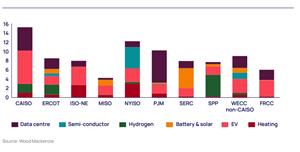
US Utilities Bracing for Unprecedented Power Demand Surge: What It Means for the Energy Landscape
In an unexpected twist, the energy sector in the United States is gearing up to face a significant challenge as power demand is projected to rise sharply for the first time in decades. According to a recent report from industry analysts, regions across the US may experience an increase of up to 15% in electricity demand by 2029. This surge is raising eyebrows, as many experts predict it will lead to escalating energy prices, impacting both consumers and businesses nationwide.
Understanding the Surge in Power Demand
The impending rise in power demand is attributed to several interconnected factors, including population growth, increased electrification of transportation, and a broader shift towards renewable energy sources. As more consumers adopt electric vehicles (EVs) and as industries increasingly rely on electricity for production, the demand for power is poised to surge.
In the past, fluctuations in energy demand were often seasonal or tied to economic upswings. However, the data suggests that this increase is not merely a temporary blip but rather a sustained trend. For instance, the rise of remote work—accelerated by the COVID-19 pandemic—has left many households using more electricity than ever before, compounding existing demand pressures.
The Ripple Effects Across Regions
Regions that are already facing energy-related challenges could be hit particularly hard. For example, states like California, which have long grappled with energy reliability issues, may find it increasingly difficult to meet the growing needs of their residents. The report highlights that places with limited resources for energy sourcing or infrastructure upgrades will be the most vulnerable as the demand intensifies.
Electricity prices, already on the rise, are expected to continue their upward trajectory from 2024 to 2029. The increasing demand could lead utilities to invest more in infrastructure—an expenditure that will likely be passed on to consumers in the form of higher bills.
The consequences of this growing demand extend beyond pricing; they also delve into sustainability concerns. Many utilities are on the path to decarbonization, focusing on renewable energy sources to mitigate climate change. However, accommodating a surge in demand while transitioning to cleaner energy may pose significant challenges. Balancing supply, affordability, and environmental responsibility will be the key to navigating this dilemma.
What Does This Mean for Consumers?
For the average American household, this forecast could mean higher energy bills and potentially more frequent outages, especially in peak usage periods. The implications extend to businesses as well; those reliant on consistent energy access may be forced to reevaluate their energy strategies. Small and large enterprises alike will need to brace for the possibility of rising operational costs due to increasing power prices.
Utilities will also likely prioritize investments in energy storage technologies and alternative energy sources that can help accommodate demand peaks. Regions that can innovate in these areas will have a competitive advantage.
Moreover, policymakers may need to step in to ensure that low-income families and vulnerable populations have access to affordable energy. Rising costs could push some households into energy poverty, a situation where families spend an excessive portion of their income on energy bills, compromising their ability to meet other basic needs.
The Role of Renewable Energy in the Future
Interestingly, the power demand surge also presents a unique opportunity for renewable energy sources like solar and wind. As utility companies look to meet growing demands sustainably, the expansion of clean energy infrastructure could become a priority. By investing in additional renewable projects and innovative grid technologies, utilities can harness the power of emerging technologies to better manage fluctuations in demand.
Government incentives and public-private partnerships may play a crucial role in accelerating this transition. Whether it’s through grants for renewable projects or improved regulations, the current landscape presents an opportune moment for stakeholders to rally together toward a more sustainable energy future.
Conclusion
As the United States prepares for this unprecedented increase in power demand, both utilities and consumers must remain alert to the challenges that lie ahead. The potential for rising prices could reshape the energy landscape dramatically, pushing both households and businesses to reconsider their energy usage and investment strategies.
With the right measures in place, from policy adjustments to technological advancements, the nation may not only weather this impending shift but also emerge with a stronger, more resilient energy framework. As we look ahead, the interplay between demand, sustainability, and affordability will chart the course for future electricity consumption and generation.
Tags
#EconomyNews #BusinessNews #US #Energy

